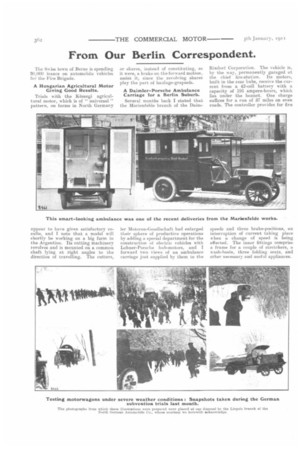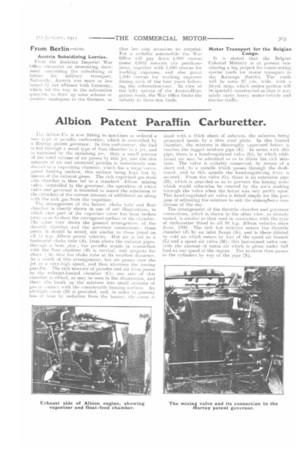From Our Berlin Correspondent.
Page 12

Page 13

If you've noticed an error in this article please click here to report it so we can fix it.
The Swiss town of Berne is spending 30,000 francs on automobile vehicles for the Fire Brigade.
A Hungarian Agricultural Motor Giving Good Results.
Trials with the Koszegi agricultural motor, which is of " universal " pattern, on farms in North Germany appear to have given satisfactory results, and I note that a model will shortly be working on a big farm in the Argentine. Its cutting machinery revolves and is mounted on a common shaft lying at right angles to the direction of travelling. The cutters, or shares, instead of constituting, as it were, a brake on the forward motion, assist it, since the revolving shares play the part of haulage-grapnels.
A Daimler-Porsche Ambulance Carriage for a Berlin Suburb.
Several months back I stated that the Marienfelde branch of the Daim ler Motoren-Gesellschaft had enlarged their sphere of productive operations by adding a special department for the construction of electric vehicles with Lohner-Porsche hub-motors, and I forward two views of an ambulance carriage just supplied by them to the Rixdorf Corporation. The vehicle is, by the way, permanently garaged at the chief fire-station. Its motors, built in the rear hubs, receive the current from a 42-cell battery with a capacity of 195 ampere-hours, which lies under the bonnet. One charge suffices for a run of 37 miles on even roads. The controller provides for five speeds and three brake-positions, an interruption of current taking place when a change of speed is being effected. The inner fittings comprise a frame for a couple of stretchers, a wash-basin, three folding seats, and other necessary and useful appliances.
Austria Subsidizing Lorries. Froi» the Austrian Imperial War Office emanates an interesting document concerning the subsidizing of
lorries for military transport. Naturally. Austria was more or less bound by her alliance with Germany, whielt led the Way in the subvention question. to draw up some scheme or another analogous to the German. so that her step occasions no surprise. For a suitable automobile the War Office will pay down 4.1100 crowns (sonic 1.:16(S) townrds the purchaseprice, together with 1,000 crowns for working expenses, and also grant 1,000 crowns for working expenses during each of the four years following the subvention-year. In view of the hilly nature of the Austro-Hungarian roads, the War Office limits the subsidy to three-ton loads. Motor Transport for the Belgian Congo.
It is stated that the Belgian Colonial Ministry is at present considering a big project for constructing special roads for motor transport ill the Katanga district. The roads tvill be some :27 yds. wide, with a 10-yd strip, which centre portion will be specially constructed so that it may safely carry heavy motor-vehicle and tractor traffie.






















